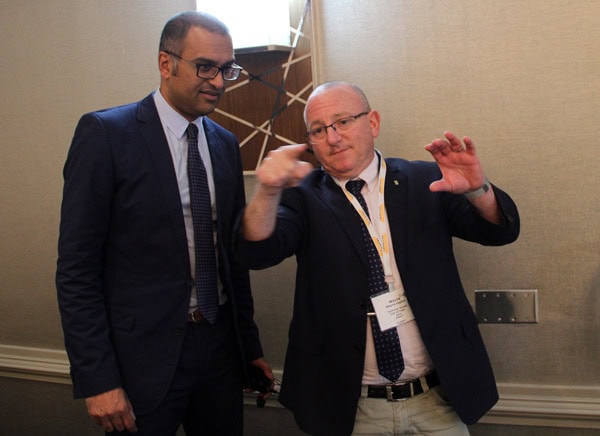
[image above] Roger de Souza (left) and Wayne Kaplan discussing after de Souza’s plenary speech at EAM. Kaplan, representing ACerS Basic Science Division, coorganized the conference. Credit: ACerS
The Conference on Electronic and Advanced Materials (EAM) wrapped up on Friday in Orlando, Fla., after three days of stimulating sessions. The weather “cooperated” and was unusually chilly, which safeguarded attendees from sunshine distraction! (See images from the event here.)
The conference, coorganized by ACerS Electronics Division and ACerS Basic Science Division, offered parallel programming by each division. Nearly 345 people from about 22 countries attended, including about 85 students.
Brady Gibbons—Electronics Division chair, EAM coorganizer, and professor at Oregon State University—says he appreciates the nurturing quality of this meeting for students. “We’re here to help the electroceramics community grow,” he says.
The camaraderie extends to the professional ranks, too. “This meeting is a nucleus for the community that we look forward to every year,” Gibbons says. “The conference fosters new relationships, and sparks new ideas, new collaborations, and new friendships.”
Both plenary sessions were exceptional and set the stage for an unexpected theme around the idea of making peace—if not friends—with defects.
In the opening plenary, Roger de Souza, professor at RWTH Aachen University (Germany), began by providing a recipe for a perfect crystal with no point or extended defects: take an infinite amount of pure crystal, and place it in an oven set to 0K for an infinite period of time.
His point is that we need to learn to live with and take advantage of defects in crystalline structures. He went on to present some elegant diffusion experiments with oxygen isotopes that effectively function as “point-defect microscopes” to test whether there is a limit to how fast ions can migrate in a solid.
Later, in a breakout session, Lane Martin, professor at University of California, Berkeley, picked up the defects in materials theme by posing a philosophical question: “Is a better material always better?”
“Sometimes, but not always. It depends on your goals,” he says. Defects are unavoidable and impact properties. “The solution has been brute force—dope or alloy to counteract defect effects, …basically swapping one defect for another.”
Martin suggests a new appreciation of defects is emerging. “New advances in processing, characterization, and theoretical modelling are beginning to redefine the ‘bad guy’ reputation of defects. They possess a set of properties/influences that when understood provide a depth of control and utility that could rival any other factor.” (See also, Martin’s article in the ACerS Bulletin (PDF) on this topic.)
This theme emerged yet again in Thursday’s plenary session talk by Judith MacManus-Driscoll, professor at University of Cambridge (England). A leading researcher on oxide thin films, her talk centered on the application opportunities for oxide thin-film devices and the challenges to overcome. She noted that epitaxial thin films are not perfect single crystals and are loaded with defects.
“The properties at the interface are rubbish, actually,” she says. “One can overcome them; they just have to be addressed.” And she says the place to look for answers is research on bulk ceramics. “We need some basic understanding of chemistry of bulk in order to understand thin film,” she says. She made the connection citing research on lanthanum strontium manganite, strontium iron molybdate, YBCO, and other complex oxide systems. Applications for thin film oxides include memristers, photocatalysis materials, high temperature superconductor wires, magnetoelectric memory, and more—all of which require engineering of the defects.
Many other themes were discussed, too. Pennsylvania State University professor, Clive Randall, and his group presented several talks on what they are learning about cold sintering. “The beauty of low temperatures is minimizing thermal processing,” Randall says. His group demonstrated cold sintering below 300˚C of ceramic–PTFE composite microwave materials, which opens an entirely new vein for thinking about engineering materials systems.
For about a decade, the race has been on to find a lead-free alternative to lead zirconate titanate piezoceramic to comply with the European Union’s Restriction on Hazardous Substances directive. Potassium sodium niobate (KNN) is a contending replacement material, but the question must be asked whether it impacts the environment more, less, or the about same.
Lenny Koh’s group at the University of Sheffield in England uses an analytical modeling tool, SCEAnTi, to consider this question with a Life Cycle Analysis focused on two aspects—embodied energy in fabricating KNN devices and toxicology. The goal, she says, is to develop a pre-research methodology to assess “is it worth doing in the first place?” She presented the surprising result that KNN is more environmentally damaging than PZT. Bismuth niobium titanate, another candidate piezoceramic replacement for PZT, has the best environmental profile in her models.
EAM continued its tradition of offering a tutorial session for graduate students, a host of networking receptions, poster session, and a conference banquet. Nate Orloff, Juergen Roedel, and Jacob Jones spoke at the conference’s post-script Failure Symposium. Organizer Geoff Brennecka, paraphrasing Yoda, the Jedi master in Star Wars, introduced them saying, “Failure the greatest teacher is. Mmmm.” The “lessons learned” were entertaining but genuine reminders that success comes with difficulty, even for the most successful researchers in the field.
Next year the conference will reassume its Electronic Materials and Applications identity. Plan now to attend EMA 2019, again in Orlando, January 23–25, 2019.

Plenary session at EAM. Credit: ACerS

Judith MacManus-Driscoll delivered Thursday’s plenary talk. Credit: ACerS

Alp Sehirlioglu (right) guides Bryan Huey through a crystal structure using Microsoft Hololens augmented reality system during the poster session. Credit: ACerS
Did you find this article interesting? Subscribe to the Ceramic Tech Today newsletter to continue to read more articles about the latest news in the ceramic and glass industry! Visit this link to get started.
Author
Eileen De Guire
Spotlight Categories
- Meeting Highlights
Divisions
- Basic Science
- Electronics


